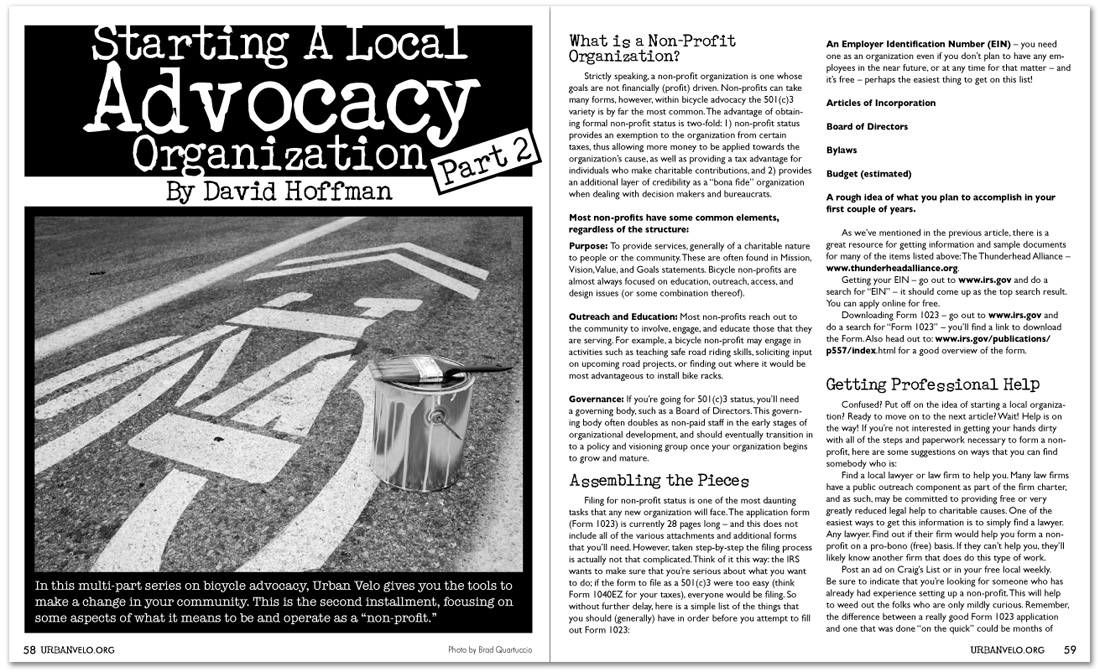
 |
|||
Starting a Local Advocacy Organization - Part IIby David Hoffman In this multi-part series on bicycle advocacy, Urban Velo gives you the tools to make a change in your community. This is the second installment, focusing on some aspects of what it means to be and operate as a “non-profit.” What is a Non-Profit Organization?Strictly speaking, a non-profit organization is one whose goals are not financially (profit) driven. Non-profits can take many forms, however, within bicycle advocacy the 501(c)3 variety is by far the most common. The advantage of obtaining formal non-profit status is two-fold: 1) non-profit status provides an exemption to the organization from certain taxes, thus allowing more money to be applied towards the organization’s cause, as well as providing a tax advantage for individuals who make charitable contributions, and 2) provides an additional layer of credibility as a “bona fide” organization when dealing with decision makers and bureaucrats. Most non-profits have some common elements, regardless of the structure: Purpose: To provide services, generally of a charitable nature to people or the community. These are often found in Mission, Vision, Value, and Goals statements. Bicycle non-profits are almost always focused on education, outreach, access, and design issues (or some combination thereof). Outreach and Education: Most non-profits reach out to the community to involve, engage, and educate those that they are serving. For example, a bicycle non-profit may engage in activities such as teaching safe road riding skills, soliciting input on upcoming road projects, or finding out where it would be most advantageous to install bike racks. Governance: If you’re going for 501(c)3 status, you’ll need a governing body, such as a Board of Directors. This governing body often doubles as non-paid staff in the early stages of organizational development, and should eventually transition in to a policy and visioning group once your organization begins to grow and mature. Assembling the PiecesFiling for non-profit status is one of the most daunting tasks that any new organization will face. The application form (Form 1023) is currently 28 pages long – and this does not include all of the various attachments and additional forms that you’ll need. However, taken step-by-step the filing process is actually not that complicated. Think of it this way: the IRS wants to make sure that you’re serious about what you want to do; if the form to file as a 501(c)3 were too easy (think Form 1040EZ for your taxes), everyone would be filing. So without further delay, here is a simple list of the things that you should (generally) have in order before you attempt to fill out Form 1023: An Employer Identification Number (EIN) – you need one as an organization even if you don’t plan to have any employees in the near future, or at any time for that matter – and it’s free – perhaps the easiest thing to get on this list! Articles of Incorporation Board of Directors Bylaws Budget (estimated) A rough idea of what you plan to accomplish in your first couple of years. As we’ve mentioned in the previous article, there is a great resource for getting information and sample documents for many of the items listed above: The Thunderhead Alliance – www.thunderheadalliance.org. Getting your EIN – go out to www.irs.gov and do a search for “EIN” – it should come up as the top search result. You can apply online for free. Downloading Form 1023 – go out to www.irs.gov and do a search for “Form 1023” – you’ll find a link to download the Form. Also head out to: www.irs.gov/publications/p557/index.html for a good overview of the form. Getting Professional HelpConfused? Put off on the idea of starting a local organization? Ready to move on to the next article? Wait! Help is on the way! If you’re not interested in getting your hands dirty with all of the steps and paperwork necessary to form a non-profit, here are some suggestions on ways that you can find somebody who is: Find a local lawyer or law firm to help you. Many law firms have a public outreach component as part of the firm charter, and as such, may be committed to providing free or very greatly reduced legal help to charitable causes. One of the easiest ways to get this information is to simply find a lawyer. Any lawyer. Find out if their firm would help you form a non-profit on a pro-bono (free) basis. If they can’t help you, they’ll likely know another firm that does do this type of work. Post an ad on Craig’s List or in your free local weekly. Be sure to indicate that you’re looking for someone who has already had experience setting up a non-profit. This will help to weed out the folks who are only mildly curious. Remember, the difference between a really good Form 1023 application and one that was done “on the quick” could be months of |
|
|